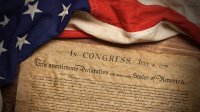Tips for Teaching the Declaration of Independence
Studying this historic document helps students understand our government and our history, and the role of citizens in public life.
Your content has been saved!
Go to My Saved Content.The U.S. Constitution is the supreme law of the land. It provides the political and legal foundations for the United States, as well the philosophy of government intended to guide our elected representatives. Teachers thus understandably focus more on the Constitution than on the U.S. Declaration of Independence. The Declaration, however, is important in its own right and presents many important learning opportunities for students.
The Declaration of Independence is more than a legal document justifying the colonies’ rebellion against Great Britain. Written principally by Thomas Jefferson in 1776, it’s a document that taps into deep questions regarding egalitarianism, natural law, and social contract theory.
The Declaration informs our relationship with government
Jefferson applied the words and thoughts of Enlightenment thinker John Locke to build his case against the British Crown, in addition to exploring questions about the role of government and the rights of citizenship.
Two main themes emerge in the Declaration: natural rights, and the concept that the function of government is to uphold and safeguard those rights.
Understanding these theories can help students better appreciate their relationship with the government.
Ask students these questions:
- What are some rights that all people have?
- How does the government protect these rights?
- Is the government doing enough to protect our rights?
- What are some ways the government might better protect our rights?
Jefferson writes that it’s the right of the people to “alter or to abolish” tyrannical government. With this in mind, citizens must also be watchdogs of the government, keeping informed of current events and abreast of issues.
I like to ask my students how we can keep our government in check these days.
The Declaration of Independence as inspirational text
The stirring language of the Declaration has inspired people throughout history. Abolitionists turned to the Declaration to make their case that slavery should be abolished. William Lloyd Garrison extolled the philosophy of the Declaration, but he burned a copy of the U.S. Constitution. John Brown reworked the Declaration to write his Declaration of Liberty.
Elizabeth Cady Stanton referenced Jefferson’s words when advocating for the rights and suffrage of American women. More than 100 years later, Martin Luther King Jr. called the Declaration a “promissory note to which every American was to fall heir.”
One way to underscore the importance of the Declaration is to make connections to the documents in which the Declaration’s words or ideas have been used.
Have students compare the Declaration of Independence with Elizabeth Cady Stanton’s 1848 Declaration of Sentiments or John Brown’s Declaration of Liberty. Note the manner in which Stanton and Brown emulate Jefferson’s words (“When in the course of human events…”) and style (the inclusion of a declaration of natural rights, a list of grievances, and a petition of redress). Students can highlight or simply list similarities.
The National Women’s History Museum provides a lesson plan that compares Stanton’s declaration with Jefferson’s. Bill of Rights Institute, moreover, offers a handout with critical thinking questions called “The Declaration and Martin Luther King, Jr.”
The Declaration of Independence didn’t just make an impact on U.S. history. The Marquis de Lafayette, who fought alongside the colonial rebels during the American Revolution, was inspired by his friend Thomas Jefferson. Lafayette drew upon the theories of John Locke and Baron de Montesquieu when the Frenchman helped author an early version of France’s Declaration of the Rights of Man and of the Citizen.
Perhaps more surprisingly, Vietnamese revolutionary Ho Chi Minh mirrors Jefferson’s language almost identically in his Declaration of Independence of the Democratic Republic of Vietnam. He began by writing, “All men are created equal,” before listing the grievances Vietnam had against France.
Teachers should consider utilizing these or other world documents inspired by the Declaration to demonstrate how Jefferson’s words transcended the plight of Britain’s American colonials and roused diverse people across space and time.
Comparing the Declaration of Independence with other primary sources is a way for students to practice textual analysis while simultaneously learning more about history and one of our most important founding documents.
Complexities of the Declaration
In the summer of 1776, when Jefferson penned the document that revolutionized humankind’s conception of freedom, his slave Robert Hemings “would have helped Jefferson dress, provided tea or a light meal, and coordinated his barber’s visits.”
What can students deduce from this tragic irony?
First, such a fact can help them recognize that history is made by flesh-and-blood people—complicated, contradictory, and deeply flawed.
Second, it’s important for students to understand that slavery was practiced by many societies for centuries. People of nearly every background and across the world would have largely accepted the ownership of other human beings as customary and unremarkable.
Thirdly, the topic of slavery at the time of America’s birth can open classrooms up to compelling discussions about the diversity of opinions that the founders had on the subject. Jefferson, for example, owned slaves, and he yet condemned the institution and authored anti-slavery legislation. Some revolutionaries, like Benjamin Franklin and John Adams, were abolitionists, while other founders unapologetically defended slavery.
The Declaration of Independence can help students reach important conclusions about the origins and influence of American political theory, the role of the citizen in public life, and the complexity of history.
